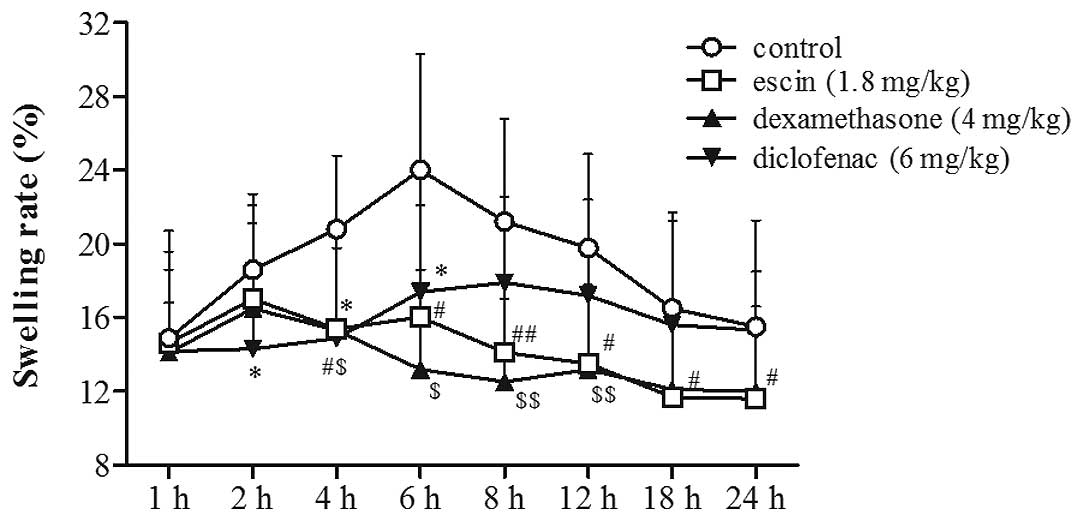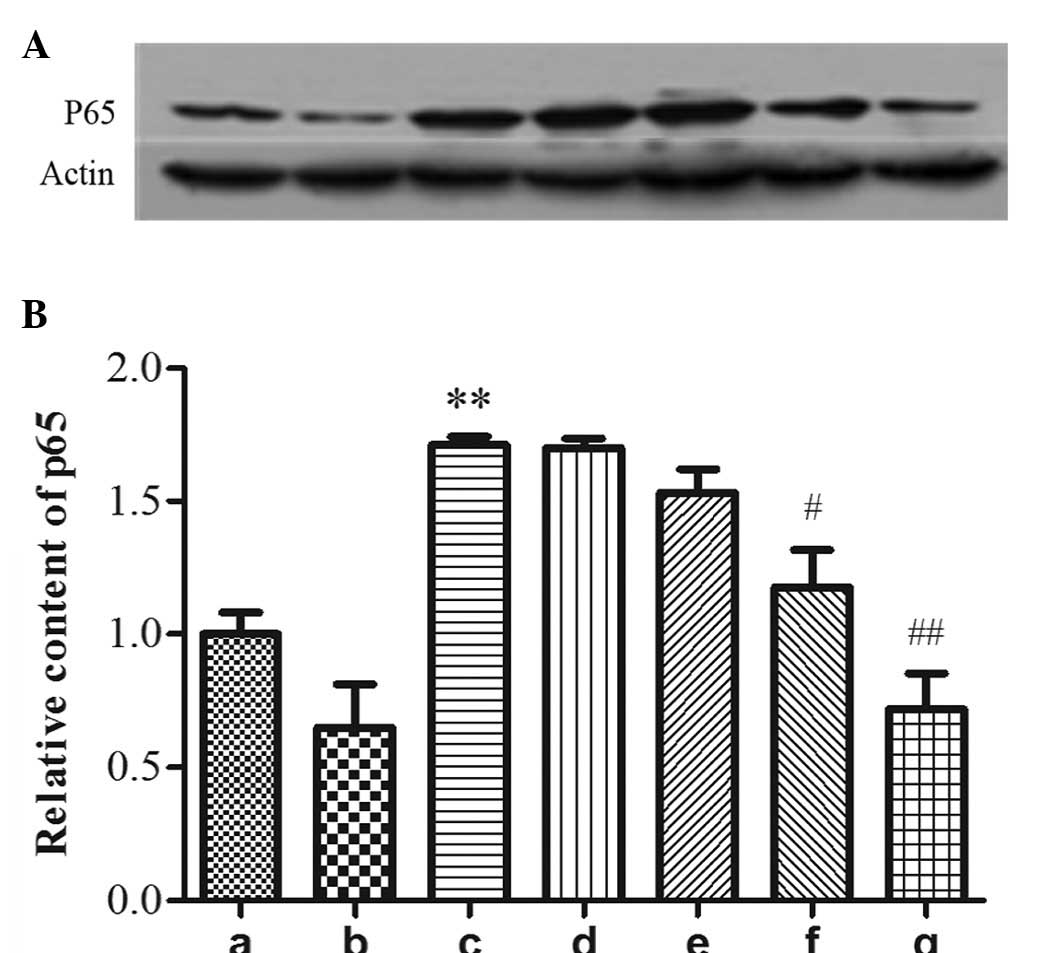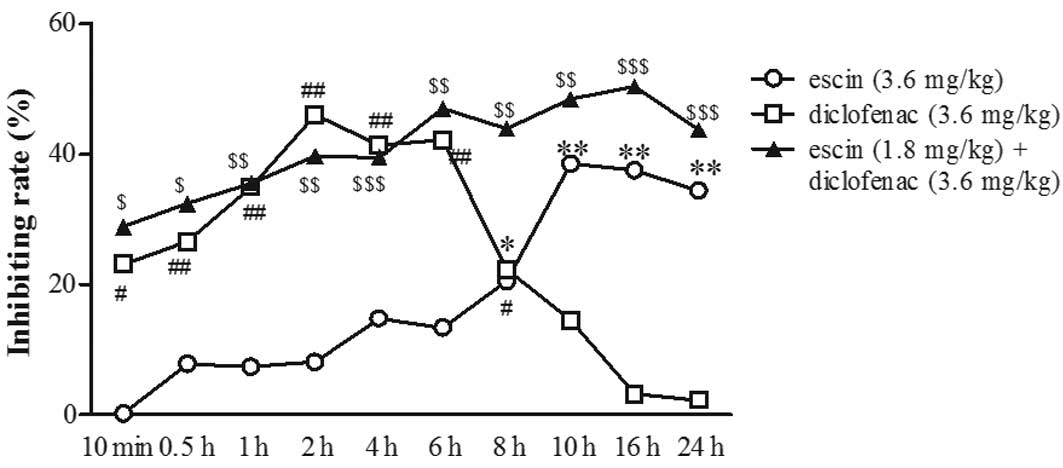Introduction
Escin is the predominant active constituent of
Aesculus hippocastanum seed extract, which is a triterpene
saponin mixture consisting of A, B, C and D escin. Accumulating
experimental results in previous studies have suggested that escin
exerts potent anti-inflammatory and anti-edematous effects
(1–4); consequently, escin is, at present,
widely used in the clinic.
The anti-inflammatory mechanisms of escin have been
documented in the description of the drug as being due to an
increase in the secretion of glucocorticoids (GCs) and
prostaglandin-F2α (PGF2α). However, our previous results
demonstrated that the anti-inflammatory effect of escin was not
dependent on the release of GCs, and, moreover, no
immunosuppressive effects were observed with GCs (5). We further identified that the
anti-inflammatory effect was correlated with an elevation in the
expression level of GC receptor (GR) protein (4).
GCs exert anti-inflammatory effects by binding to
GRs, which, upon activation, translocate to the nucleus and inhibit
proinflammatory transcription factors, such as nuclear factor-κB
(NF-κB) (6). It has been reported
that escin may aid tumor suppression by downregulating NF-κB
(7,8). However, whether the anti-inflammatory
effects of escin are mediated by the GR/NF-κB signaling pathway has
remained undetermined.
PGF2α is a member of the prostaglandin (PG) family
that is important in the modulation of inflammation. PGF2α differs
from other PGs, such as PGF1 and PGE2, in that it is able to
contract blood vessels, facilitate venous return and improve lymph
transport, and thus counteracts the exudation and edema induced by
inflammatory mediators (9–13). It has been indicated that escin is
able to increase the secretion of PGF2α from vascular endothelial
cells (14–16); however, it has not been determined
whether the anti-inflammatory mechanisms of escin occur as a result
of this increased secretion of PGF2α.
In the present study, we investigated the GC-like
anti-inflammatory effects of escin, and studied the functions of
PGF2α and NF-κB in these effects.
Materials and methods
Animals
Male Swiss mice (weight, 18–22 g) and male Wistar
rats (weight, 160–200 g) were purchased from the Experimental
Animal Center of Shandong Luye Pharmaceutical Co., Ltd. (Yantai,
China). All experimental procedures performed in this study were
executed in accordance with the Yantai University (Yantai, China)
guidelines for the care and use of laboratory animals, and were
approved by the ethics committee of the university. The animals
were housed in diurnal lighting conditions (12/12 h) and were
allowed free access to food and water.
Drugs and materials
The escin used in the experiments was in the form of
sodium aescinate, obtained as a lyophilized powder in a 5 mg vial
(batch no. 201004144; Shandong Luye Pharmaceutical Co., Ltd.).
Diclofenac sodium tablets were purchased from the Sichuan Shuzhong
Pharmaceutical Group (batch no. 0908032; Guanghan, China), and
diclofenac sodium injections were obtained from the Chongqing
Laimei Pharmaceutical Co., Ltd. (batch no. 20100805; Chongqing,
China). The dexamethasone sodium phosphate injections used in the
study were purchased from the Tianjin Pharmaceutical Group Corp.
(batch no. 1009231; Hedong, China), while the λ-carrageenan was
purchased from Sigma-Aldrich (batch no. 1408463V; Shanghai, China).
The Escherichia coli O55:B5 lipopolysaccharide (LPS) was
purchased from Sigma-Aldrich. The primary and secondary antibodies
to NF-κB were obtained from the Beyotime Institute of Biotechnology
(Haimen, China).
Carrageenan-induced paw edema model
Forty Wistar rats were randomly divided into
control, dexamethasone (4 mg/kg), escin (1.8 mg/kg) and diclofenac
(6 mg/kg) groups. Carrageenan (0.1 ml, 1% w/v) was injected into
the right-hind paw (sub-plantar) of the rats, and the corresponding
drugs were administered (intragastrically for diclofenac, and
intravenously for dexamethasone and escin) 30 min later. The paw
volume was measured with a hydroplethysmometer (Shandong Academy of
Medical Sciences, Jinan, China) prior to the irritant injection,
and at selected intervals (1, 2, 4, 6, 8, 12, 18 and 24 h)
subsequent to the administration of the drugs. The results are
expressed as the increase in paw volume (ml), which was calculated
by subtracting the basal volume.
LPS-induced inflammatory model
Twenty-one mice were assigned to seven groups: the
control, LPS, escin (3.6 mg/kg), LPS plus dexamethasone (4.0 mg/kg)
and three LPS plus escin groups (0.9, 1.8 and 3.6 mg/kg). The
corresponding drugs or saline were administered intravenously 2 h
prior to the LPS treatment (40 mg/kg, intravenously). Six hours
subsequent to the LPS injection, fresh liver tissues (60 mg) were
homogenized in an ice-cold lysis buffer (Beyotime Institute of
Biotechnology), with a 1:100 volume of phenylmethylsulfonyl
fluoride (PMSF). The homogenate was centrifuged at 14,000 × g for 5
min at 4°C, and then 50 μg of the proteins obtained were
separated using 10% sodium dodecyl sulfate-polyacrylamide gel
electrophoresis (SDS-PAGE) gels. The blots were subsequently
transferred to nitrocellulose membranes, and incubated in blocking
buffer (5% skimmed milk in Tris-buffered saline solution with Tween
20), prior to further incubation with rabbit polyclonal anti-NF-κB
p65 in diluent buffer (both purchased from Beyotime Institute of
Biotechnology) overnight at 4°C (1:1,000 dilution). Following this,
the blots were incubated with the corresponding secondary antibody
conjugated with horseradish peroxidase, for 2 h at room
temperature.
Anti-β-actin antibody (Beyotime Institute of
Biotechnology) was used as the loading control, and the blots were
then developed by enhanced chemiluminescence (Amersham Biosciences,
Piscataway, NJ, USA). Densitometric techniques were applied to
quantify the protein band densities (ImageJ software; Rasband WS,
US National Institute of Health, Bethseda, MD, USA), which were
expressed as relative densitometric units of the corresponding
β-actin control.
Acetic acid-induced capillary
permeability model
One hundred and twenty mice were randomly divided
into four groups: the control, escin (3.6 mg/kg), diclofenac (3.6
mg/kg) and escin plus diclofenac (1.8 and 3.6 mg/kg, respectively)
groups. The mice were treated with the same volume of normal saline
solution or drug via the tail vein. At 10 min, and 0.5, 1, 2, 4, 6,
8, 10, 16 and 24 h subsequent to the drug administration, three
mice in each group were injected intravenously with 0.2 ml 1.0%
Evans Blue (Sigma, St. Louis, MO, USA) in saline solution via the
tail vein, before 0.2 ml 1% (v/v) acetic acid in saline solution
was injected intraperitoneally. Twenty minutes later, the mice were
sacrificed, and the viscera were exposed and irrigated with 3 ml
distilled water, which was then filtered through glass wool into 10
ml volumetric flasks. Each flask was made up to a 10 ml final
volume with distilled water, and 0.1 ml NaOH solution (0.1 M) was
added. The absorption of the final solution was measured at 590 nm
using an automated enzyme-linked immunosorbent assay (ELISA) reader
(Synergy™ HT Multi-Mode Microplate Reader; BioTek Instruments,
Inc., Winooski, VT, USA). The inhibition level was calculated using
the following formula: Inhibition (%) = (1−Ac/At) × 100, where Ac
and At are the average absorptions of the saline-treated control
group and the drug-treated group, respectively.
Statistical analysis
All data are expressed as the mean ± standard error
of the mean (SEM). The statistical significance of differences
between the groups was determined by analysis of variance (ANOVA),
followed by the Student’s t-test. P<0.05 was considered to
indicate a statistically significant difference.
Results
Effects of escin on carrageenan-induced
paw edema in rats
Treatment with escin (1.8 mg/kg) significantly
inhibited the development of paw edema from 4 to 24 h following
administration (P<0.05). Similarly, dexamethasone (4.0 mg/kg)
significantly reduced the carrageenan-induced paw edema from 4 to
12 h following administration (P<0.05). In addition, the mean
values of the swelling rate in the dexamethasone group at 18 and 24
h (12.1±4.7 and 12.0±4.6%, respectively) were equivalent to those
of the escin group (11.7±3.9 and 11.6±3.6%, respectively). Unlike
escin or dexamethasone, diclofenac (6.0 mg/kg) significantly
inhibited the development of paw edema from 2 to 6 h following
administration (P<0.05; Fig.
1).
Effects of escin on NF-κB protein
expression in LPS-treated mice
The administration of LPS increased the protein
expression level of the NF-κB p65 subunit significantly
(P<0.01), unlike the administration of escin alone, which did
not significantly affect the expression of the p65 subunit in the
livers of the mice (P>0.05). In the LPS plus escin groups, 1.8
and 3.6 mg/kg escin significantly inhibited the protein expression
of the NF-κB p65 subunit that was induced by the LPS administration
(P<0.05 and P<0.01, respectively; Fig. 2).
Anti-inflammatory effects of escin plus
diclofenac on a mouse model of acetic acid-induced capillary
permeability
Diclofenac (3.6 mg/kg) significantly inhibited the
acetic acid-induced capillary permeability from 10 min to 8 h
following administration. A similar effect was observed with escin
(3.6 mg/kg), which significantly inhibited the capillary
permeability from 8 to 24 h following administration. The
coadministration of escin and diclofenac (1.8 and 3.6 mg/kg,
respectively) significantly inhibited the capillary permeability
from 10 min to 24 h following administration (Fig. 3).
Discussion
The GR is a member of the nuclear receptor family
that is activated by GCs. Upon activation, the GR translocates to
the nucleus and inhibits proinflammatory transcription factors,
such as NF-κB, thereby reducing the inflammatory reaction (17,18).
In a previous study, we demonstrated that escin
elevated the expression of the GR, and reduced the liver injury
induced by endotoxins in mice (4).
However, it has remained unclear whether the anti-inflammatory
mechanism of escin involves the GR/NF-κB signaling pathway. In the
present study, we showed that escin exhibited potent GC-like
anti-inflammatory effects against carrageenan-induced paw edema and
acetic acid-induced capillary permeability. In addition, we
demonstrated that escin significantly inhibited the expression of
p65 in the livers of mice with LPS-induced sepsis. These results
indicate that the anti-inflammatory effects of escin may occur
through the GR/NF-κB pathway.
PGs are generated from the action of cyclooxygenases
(COXs) on arachidonic acid. Diclofenac, a non-steroidal
anti-inflammatory drug, potently inhibits the activity of COXs
(19) and reduces the arachidonic
acid level in plasma (20), and
thus greatly inhibits the biosynthesis of PGs, such as PGD, PGE and
PGF. An increase in PGF2α secretion from vascular endothelial cells
has traditionally been considered as a critical factor for the
anti-inflammatory effect of escin, and this has been documented in
the description of the drug. However, in our present study, the
results demonstrated that diclofenac did not exert any negative
influence on the anti-inflammatory effect of escin. This indicated
that the effect exerted by escin was not dependent on the increase
in PGF2α secretion.
With the results from our present and previous
studies, we may conclude that escin exhibits potent
glucocorticoid-like anti-inflammatory effects, the mechanism of
which may involve GR/NF-κB pathway; however, the effects do not
depend on an increase in PGF2α secretion. These results may be
useful in the further elucidation of the anti-inflammatory
mechanism of escin, and to rationalize its clinical
application.
Acknowledgements
This study was supported by the
Taishan Scholar Project, the National Natural Science Foundation of
China (grant no. 30772760), the Foundation for Outstanding
Middle-age and Young Scientists (No. BS2011YY061) and the Doctoral
Foundation of Yantai University (grant no. YX11B31).
References
|
1.
|
Fu F, Hou Y, Jiang W, Wang R and Liu K:
Escin: inhibiting inflammation and promoting gastrointestinal
transit to attenuate formation of postoperative adhesions. World J
Surg. 29:1614–1620. 2005. View Article : Google Scholar : PubMed/NCBI
|
|
2.
|
Zhang L, Fu F, Zhang X, Zhu M, Wang T and
Fan H: Escin attenuates cognitive deficits and hippocampal injury
after transient global cerebral ischemia in mice via regulating
certain inflammatory genes. Neurochem Int. 57:119–127. 2010.
View Article : Google Scholar
|
|
3.
|
Xin W, Zhang L, Fan H, Jiang N, Wang T and
Fu F: Escin attenuates acute lung injury induced by endotoxin in
mice. Eur J Pharm Sci. 42:73–80. 2011. View Article : Google Scholar : PubMed/NCBI
|
|
4.
|
Jiang N, Xin W, Wang T, Zhang L, Fan H, Du
Y, Li C and Fu F: Protective effect of aescin from the seeds of
Aesculus hippocastanum on liver injury induced by endotoxin
in mice. Phytomedicine. 18:1276–1284. 2011. View Article : Google Scholar : PubMed/NCBI
|
|
5.
|
Zhang L, Wang H, Fan H, Wang T, Jiang N,
Yu P and Fu F: The potent anti-inflammatory agent escin does not
increase corticosterone secretion and immune cell apoptosis in
mice. Fitoterapia. 82:861–867. 2011. View Article : Google Scholar : PubMed/NCBI
|
|
6.
|
Rhen T and Cidlowski JA: Antiinflammatory
action of glucocorticoids - new mechanisms for old drugs. N Engl J
Med. 353:1711–1723. 2005. View Article : Google Scholar : PubMed/NCBI
|
|
7.
|
Wang YW, Wang SJ, Zhou YN, Pan SH and Sun
B: Escin augments the efficacy of gemcitabine through
down-regulation of nuclear factor-κB and nuclear
factor-κB-regulated gene products in pancreatic cancer both in
vitro and in vivo. J Cancer Res Clin Oncol. 138:785–797.
2012.PubMed/NCBI
|
|
8.
|
Harikumar KB, Sung B, Pandey MK, Guha S,
Krishnan S and Aggarwal BB: Escin, a pentacyclic triterpene,
chemosensitizes human tumor cells through inhibition of nuclear
factor-kappaB signaling pathway. Mol Pharmacol. 77:818–827. 2010.
View Article : Google Scholar
|
|
9.
|
Williams PB and Joyner JH: Response of
peripheral collateral arteries in the dog to prostaglandins E1, E2,
F2 alpha, and I2 (prostacyclin). J Cardiovasc Pharmacol. 4:784–790.
1982. View Article : Google Scholar : PubMed/NCBI
|
|
10.
|
Emerson TE Jr, Jelks GW, Daugherty RM Jr
and Hodgman RE: Effects of prostaglandin E1 and F2 alpha on venous
return and other parameters in the dog. Am J Physiol. 220:243–249.
1971.PubMed/NCBI
|
|
11.
|
Uski TK, Andersson KE, Brandt L and
Ljunggren B: Characterization of the prostanoid receptors and of
the contractile effects of prostaglandin F2 alpha in human pial
arteries. Acta Physiol Scand. 121:369–378. 1984. View Article : Google Scholar : PubMed/NCBI
|
|
12.
|
Amann-Vesti BR, Gitzelmann G,
Koppensteiner R and Franzeck UK: Isoprostane 8-epi-prostaglandin F2
alpha decreases lymph capillary pressure in patients with primary
lymphedema. J Vasc Res. 40:77–82. 2003. View Article : Google Scholar : PubMed/NCBI
|
|
13.
|
Sinzinger H, Oguogho A and Kaliman J:
Isoprostane 8-epi-prostaglandin F2 alpha is a potent contractor of
human peripheral lymphatics. Lymphology. 30:155–159.
1997.PubMed/NCBI
|
|
14.
|
Longiave D, Omini C, Nicosia S and Berti
F: The mode of action of aescin on isolated veins: relationship
with PGF2 alpha. Pharmacol Res Commun. 10:145–152. 1978. View Article : Google Scholar : PubMed/NCBI
|
|
15.
|
Berti F, Omini C and Longiave D: The mode
of action of aescin and the release of prostaglandins.
Prostaglandins. 14:241–249. 1977. View Article : Google Scholar : PubMed/NCBI
|
|
16.
|
Carrasco OF and Vidrio H: Endothelium
protectant and contractile effects of the antivaricose principle
escin in rat aorta. Vascul Pharmacol. 47:68–73. 2007. View Article : Google Scholar : PubMed/NCBI
|
|
17.
|
Lu NZ, Wardell SE, Burnstein KL, Defranco
D, Fuller PJ, Giguere V, Hochberg RB, McKay L, Renoir JM, Weigel
NL, et al: International Union of Pharmacology. LXV. The
pharmacology and classification of the nuclear receptor
superfamily: glucocorticoid, mineralocorticoid, progesterone, and
androgen receptors. Pharmacol Rev. 58:782–797. 2006. View Article : Google Scholar
|
|
18.
|
Mckay LI and Cidlowski JA: Molecular
control of immune/inflammatory responses: interactions between
nuclear factor-kappa B and steroid receptor-signaling pathways.
Endocrine Rev. 20:435–459. 1999.
|
|
19.
|
Ku EC, Wasvary JM and Cash WD: Diclofenac
sodium (GP 45840, Voltaren), a potent inhibitor of prostaglandin
synthetase. Biochem Pharmacol. 24:641–643. 1975. View Article : Google Scholar : PubMed/NCBI
|
|
20.
|
Ku EC, Kothari H, Lee W, Kimble EF and
Liauw LH: Effects of diclofenac sodium on arachidonic acid
metabolism. Agents Actions Suppl. 17:189–193. 1985.PubMed/NCBI
|

















